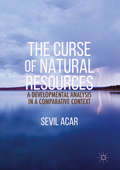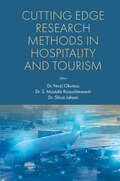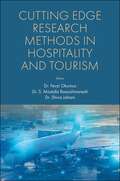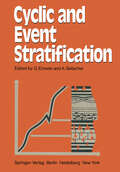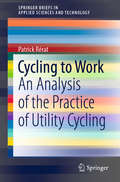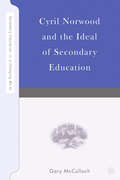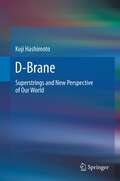- Table View
- List View
The Curse of Natural Resources: A Developmental Analysis in a Comparative Context
by Sevil AcarThis book examines the paradox that resource-rich countries often struggle to manage their resources in a way that will help their economies thrive. It looks at how a country's political regime and quality of governance can determine the degree to which it benefits - or suffers - from having natural resources, shifting away from the traditional focus on economic growth data to study the complex implications of these resources for human well-being and sustainable development. To this end, Acar examines a panel of countries in terms of the effects of their natural resources on human development and genuine saving, which is a sustainability indicator that takes into account the welfare of future generations by incorporating the changes in different kinds of capital. Acar finds that the exportation of agricultural raw materials is associated with significant deterioration in human development, while extractive resource exports, such as energy and minerals, have negative implications for genuine savings. Next, the book compares the development path of Norway before and after discovering oil, contrasting it with Sweden's development. The two countries, which followed almost identical paths until the 1970s, diverged significantly in terms of per capita income after Norway found oil.
Curvilinear Micromagnetism: From Fundamentals to Applications (Topics in Applied Physics #146)
by Denys Makarov Denis D. ShekaThis is the first book providing overview of magnetism in curved geometries, highlighting numerous peculiarities emerging from geometrically curved magnetic objects such as curved wires, shells, as well as complex three-dimensional structures. Extending planar two-dimensional structures into the three-dimensional space has become a general trend in multiple disciplines across electronics, photonics, plasmonics and magnetics. This approach provides the means to modify conventional and even launch novel functionalities by tailoring the local curvature of an object. The book covers the theory of curvilinear micromagnetism as well as experimental studies of geometrically curved magnets including both fabrication and characterization. With its coverage of fundamental aspects, together with exploration of numerous applications across magnonics, bio-engineering, soft robotics and shapeable magnetoelectronics, this edited collection is ideal for all scientists in academia and industry seeking an overview and wishing to keep abreast of advances in the novel field of curvilinear micromagnetism. It provides easy but comprehensive access to the field for newcomers, and can be used for graduate-level courses on this subject.
The Custodians of Biodiversity: Sharing Access to and Benefits of Genetic Resources
by Manuel Ruiz Ronnie VernooyGlobally, local and indigenous approaches to conserving biodiversity, crop improvement, and managing precious natural resources are under threat. Many communities have to deal with 'biopiracy,' for example. As well, existing laws are usually unsuitable for protecting indigenous and traditional knowledge and for recognizing collective rights, such as in cases of participatory plant breeding, where farmers, researchers and others join forces to improve existing crop varieties or develop new ones, based on shared knowledge and resources. This book addresses these issues. It outlines the national and international policy processes that are currently underway to protect local genetic resources and related traditional knowledge and the challenges these initiatives have faced. In particular these themes are addressed within the context of the Convention of Biological Diversity and the International Treaty on Plant Genetic Resources for Food and Agriculture. The authors broaden the policy and legal debates beyond the sphere of policy experts to include the knowledge-holders themselves. These are the 'custodians of biodiversity': farmers, herders and fishers in local communities. Their experience in sharing access and benefits to genetic resources is shown to be crucial for the development of effective national and international agreements. The book presents and analyzes this experience, including case studies from China, Cuba, Honduras, Jordan, Nepal, Peru and Syria. Copublished with the International Development Research Centre (IDRC).
The Custodians of Biodiversity: Sharing Access to and Benefits of Genetic Resources
by Manuel Ruiz Ronnie VernooyGlobally, local and indigenous approaches to conserving biodiversity, crop improvement, and managing precious natural resources are under threat. Many communities have to deal with 'biopiracy,' for example. As well, existing laws are usually unsuitable for protecting indigenous and traditional knowledge and for recognizing collective rights, such as in cases of participatory plant breeding, where farmers, researchers and others join forces to improve existing crop varieties or develop new ones, based on shared knowledge and resources. This book addresses these issues. It outlines the national and international policy processes that are currently underway to protect local genetic resources and related traditional knowledge and the challenges these initiatives have faced. In particular these themes are addressed within the context of the Convention of Biological Diversity and the International Treaty on Plant Genetic Resources for Food and Agriculture. The authors broaden the policy and legal debates beyond the sphere of policy experts to include the knowledge-holders themselves. These are the 'custodians of biodiversity': farmers, herders and fishers in local communities. Their experience in sharing access and benefits to genetic resources is shown to be crucial for the development of effective national and international agreements. The book presents and analyzes this experience, including case studies from China, Cuba, Honduras, Jordan, Nepal, Peru and Syria. Copublished with the International Development Research Centre (IDRC).
Cut Flowers and Foliages (Crop Production Science in Horticulture)
by Raul I Cabrera Elizabeth Cieniewicz Melissa Muñoz Henry WainwrightThe cut flower and foliage industry is a global business with major production locations in North America, South America, Central America, East Africa, Europe, the Middle East, Asia, Australia and New Zealand. Few other horticulture crops are as ubiquitous, yet the production techniques and challenges are universal. This book describes the main international production locations and markets, including current trends and directions. The focus is on production in protected cultivation. The major species - including rose, chrysanthemum, carnation, orchid and gerbera - dominate the global market and these are individually explored in detail. Specialty species and cut foliages are also addressed, as well as significant details of production, including irrigation and fertilization, disease and disease management, and biological control of pests. Finally, the postharvest chapter covers details of harvesting, transporting and delivering high quality flowers that provide an excellent vase life. Highly illustrated with color photos throughout, this is an essential resource for students and researchers in horticulture, growers and producers, and those in the floriculture industry.
Cutting Edge Research Methods in Hospitality and Tourism
by Fevzi Okumus, S. Mostafa Rasoolimanesh, and Shiva JahaniCutting Edge Research Methods in Hospitality and Tourism sits at the forefront of fast-paced developments in the tourism and hospitality industry, highlighting the importance of applied and pure research to address the theoretical and practical problems and gaps. Approaching from different perspectives including economic, social, cultural, environmental, political, and technological, this edited collection reviews traditional research methods and re-assesses them to suit contemporary problems and research agendas. Developing recent research strategies under the umbrella of quantitative and qualitative research methods – such as the use of structural equation modeling analysis, applied econometric research, network theory and social network analysis, using tracking mobility and planning exercises, fuzzy-set Qualitative Comparative Analysis, necessary condition analysis, and netnography approaches – can offer promising solutions. A necessity for academics and practitioners in the tourism and hospitality sector, Cutting Edge Research Methods in Hospitality and Tourism expands existing knowledge, generating innovative research.
Cutting Edge Research Methods in Hospitality and Tourism
by Fevzi Okumus S. Mostafa Rasoolimanesh Shiva JahaniCutting Edge Research Methods in Hospitality and Tourism sits at the forefront of fast-paced developments in the tourism and hospitality industry, highlighting the importance of applied and pure research to address the theoretical and practical problems and gaps. Approaching from different perspectives including economic, social, cultural, environmental, political, and technological, this edited collection reviews traditional research methods and re-assesses them to suit contemporary problems and research agendas. Developing recent research strategies under the umbrella of quantitative and qualitative research methods – such as the use of structural equation modeling analysis, applied econometric research, network theory and social network analysis, using tracking mobility and planning exercises, fuzzy-set Qualitative Comparative Analysis, necessary condition analysis, and netnography approaches – can offer promising solutions. A necessity for academics and practitioners in the tourism and hospitality sector, Cutting Edge Research Methods in Hospitality and Tourism expands existing knowledge, generating innovative research.
Cyber-Physical Systems in the Built Environment
by Chimay J. Anumba Nazila Roofigari-EsfahanThis book introduces researchers and practitioners to Cyber-Physical Systems (CPS) and its applications in the built environment. It begins with a fundamental introduction to CPS technology and associated concepts.It then presents numerous examples of applications from managing construction projects to smart transportation systems and smart cities. It concludes with a discussion of future directions for CPS deployment in the construction, operation and maintenance of constructed facilities. Featuring internationally recognized experts as contributors, Cyber-Physical Systems in the Built Environment, is an ideal resource for engineers, construction managers, architects, facilities managers, and planners working on a range of building and civil infrastructure projects.
Cybercartography: Theory And Practice (Modern Cartography Ser. (PDF))
by D. R. Fraser Taylor Tracey LauriaultFor generations, the map has been central to how societies function all over the world. Cybercartography is a new paradigm for maps and mapping in the information era. Defined as "the organization, presentation, analysis and communication of spatially referenced information on a wide variety of topics of interest to society,? cybercartography is presented in an interactive, dynamic, multisensory format with the use of multimedia and multimodal interfaces. Cybercartography: Theory and Practice examines the major elements of cybercartography and emphasizes the importance of interaction between theory and practice in developing a paradigm which moves beyond the concept of Geographic Information Systems and Geographical Information Science. It argues for the centrality of the map as part of an integrated information, communication, and analytical package. This volume is a result of a multidisciplinary team effort and has benefited from the input of partners from government, industry and other organizations. The international team reports on major original cybercartographic research and practice from a variety of disciplinary perspectives, including the humanities, social sciences including human factors psychology, cybernetics, English literature, cultural mediation, cartography, and geography. This new synthesis has intrinsic value for industries, the general public, and the relationships between mapping and the development of user-centered multimedia interfaces.
CyberGIS for Geospatial Discovery and Innovation (GeoJournal Library #118)
by Shaowen Wang Michael F. GoodchildThis book elucidates how cyberGIS (that is, new-generation geographic information science and systems (GIS) based on advanced computing and cyberinfrastructure) transforms computation- and data-intensive geospatial discovery and innovation. It comprehensively addresses opportunities and challenges, roadmaps for research and development, and major progress, trends, and impacts of cyberGIS in the era of big data. The book serves as an authoritative source of information to fill the void of introducing this exciting and growing field. By providing a set of representative applications and science drivers of cyberGIS, this book demonstrates how cyberGIS has been advanced to enable cutting-edge scientific research and innovative geospatial application development. Such cyberGIS advances are contextualized as diverse but interrelated science and technology frontiers. The book also emphasizes several important social dimensions of cyberGIS such as for empowering deliberative civic engagement and enabling collaborative problem solving through structured participation. In sum, this book will be a great resource to students, academics, and geospatial professionals for leaning cutting-edge cyberGIS, geospatial data science, high-performance computing, and related applications and sciences.
Cybernetical Physics: From Control of Chaos to Quantum Control (Understanding Complex Systems)
by A. FradkovCybernetical physics borrows methods from both theoretical physics and control engineering. It deals with the control of complex systems is one of the most important aspects in dealing with systems exhibiting nonlinear behavior or similar features that defy traditional control techniques. This book fully details this new discipline.
Cybersecurity, Privacy and Freedom Protection in the Connected World: Proceedings of the 13th International Conference on Global Security, Safety and Sustainability, London, January 2021 (Advanced Sciences and Technologies for Security Applications)
by Hamid Jahankhani Arshad Jamal Shaun LawsonThis book provides an opportunity for investigators, government officials, systems scientists, strategists, assurance researchers, owners, operators and maintainers of large, complex and advanced systems and infrastructures to update their knowledge with the state of best practice in the challenging domains whilst networking with the leading representatives, researchers and solution providers. Drawing on 12 years of successful events on information security, digital forensics and cyber-crime, the 13th ICGS3-20 conference aims to provide attendees with an information-packed agenda with representatives from across the industry and the globe. The challenges of complexity, rapid pace of change and risk/opportunity issues associated with modern products, systems, special events and infrastructures. In an era of unprecedented volatile, political and economic environment across the world, computer-based systems face ever more increasing challenges, disputes and responsibilities, and whilst the Internet has created a global platform for the exchange of ideas, goods and services, it has also created boundless opportunities for cyber-crime. As an increasing number of large organizations and individuals use the Internet and its satellite mobile technologies, they are increasingly vulnerable to cyber-crime threats. It is therefore paramount that the security industry raises its game to combat these threats. Whilst there is a huge adoption of technology and smart home devices, comparably, there is a rise of threat vector in the abuse of the technology in domestic violence inflicted through IoT too. All these are an issue of global importance as law enforcement agencies all over the world are struggling to cope.
Cyclic Homology in Non-Commutative Geometry (Encyclopaedia of Mathematical Sciences #121)
by Joachim Cuntz Georges Skandalis Boris TsyganContributions by three authors treat aspects of noncommutative geometry that are related to cyclic homology. The authors give rather complete accounts of cyclic theory from different points of view. The connections between (bivariant) K-theory and cyclic theory via generalized Chern-characters are discussed in detail. Cyclic theory is the natural setting for a variety of general abstract index theorems. A survey of such index theorems is given and the concepts and ideas involved in these theorems are explained.
Cycling and Recycling: Histories of Sustainable Practices (Environment in History: International Perspectives #7)
by Ruth Oldenziel and Helmuth TrischlerTechnology has long been an essential consideration in public discussions of the environment, with the focus overwhelmingly on creating new tools and techniques. In more recent years, however, activists, researchers, and policymakers have increasingly turned to mobilizing older technologies in their pursuit of sustainability. In fascinating case studies ranging from the Early Modern secondhand trade to utopian visions of human-powered vehicles, the contributions gathered here explore the historical fortunes of two such technologies—bicycling and waste recycling—tracing their development over time and providing valuable context for the policy successes and failures of today.
Cycling Through the Pandemic: Tactical Urbanism and the Implementation of Pop-Up Bike Lanes in the Time of COVID-19 (The Urban Book Series)
by Nathalie Ortar Patrick RératThis open access book provides insight on how the tactical urbanism has the capacity to influence change in mobility practices such as cycling. COVID-19 crisis prompted the public authorities to rethink the use of public space in order to develop means of transport that are both efficient and adapted to the health context and their effects on cycling practices in Europe, North, and South America. Its contributors collectively reveal and evidence through policies analysis, mapping, and innovative qualitative analysis bridging video and interviews, how those new infrastructures and policies can be a trigger for change in a context of mobility transition.This book provides an important element on the way local authorities can act in a quicker and more agile way. While some decisions are specific to the context of the beginning of the pandemic, the analysis offers lessons on the way to implement the transition toward a low-carbon mobility, on the importance of processes based on trials and errors, on the political stakes of reallocating road space.
Cycling to Work: An Analysis of the Practice of Utility Cycling (SpringerBriefs in Applied Sciences and Technology)
by Patrick RératThis book presents a thorough discussion of utility cycling, cycling in the urban environment, and everyday mobility. It is based on large survey answered by 14,000 participants in the bike to work action in Switzerland, and quantifies the various dimensions of utility cycling.It proposes an innovative theoretical framework to analyse and understand the various dimensions of the uses of bikes and their diversity. It addresses the factors that motivate commuters to get on their bike, and highlights the barriers to this practice between deficient infrastructures and lack of legitimacy. This research makes a diagnosis and discusses the way to develop this sustainable mode of transportation. By combining quantitative results in the form of tables, figures, and maps, and including qualitative results in the form of quotations from survey participants, this book provides a thorough and enjoyable read. It will be of interest to researchers, policy makers, advanced students in the field of urban planning, social sciences, and transportation.
Cyclones in Southern Africa: Volume 1: Interfacing the Catastrophic Impact of Cyclone Idai with SDGs in Zimbabwe (Sustainable Development Goals Series)
by Godwell Nhamo David ChikodziThere is evidence that the world has been witnessing more intense tropical cyclones. Accompanying these tropical cyclones are heightened levels of devastation that witness the loss of human life and wildlife, destruction of natural resources and property and the disruption of major economic and social activities. To this end, there is a growing demand for publications focusing on tropical cyclones at various levels that include regional, national and local levels, especially from Africa. One sub-region that has been witnessing the harsh realities of the increasing intensity of tropical cyclones in southern Africa. However, within this region, countries are usually impacted at varying degrees of damage. Among the countries that usually encounter the harshness of these tropical cyclones are the Comoros, Botswana, Madagascar, Mauritius, Malawi, Mozambique, Reunion, the Seychelles, South Africa and Zimbabwe. From the history books, the following tropical cyclones made landfall and hit southern Africa: Eline (2000), Favio (2007), Dineo (2017), Idai (2019), Kenneth (2019), Eliose (2021), and Chalane (2020). Although all these tropical cyclones had negative impacts, it is undoubtedly Tropical Cyclone Idai that shocked the world with its devastation mainly in Mozambique, Malawi and Zimbabwe in March 2019. Key infrastructure was destroyed, livelihoods were lost, and the environment was degraded. Thousands of people died, many more were injured, many remain unaccounted for and others remained homeless as of the time of finalising this book in February 2021. This book, therefore focuses on the devastating impacts of Tropical Cyclone Idai in Zimbabwe. The book interfaces Tropical Cyclone Idai’s impacts with the 2030 Agenda for Sustainable Development and some of the 17 Sustainable Development Goals (SDGs). This linkage was deliberate given that there is still time remaining until 2030, and the world has generally agreed to move into the future along the pathways of sustainable development and sustainability. The book adds to the first comprehensive profiling of the impacts of tropical cyclones on southern African economies, particularly that of Zimbabwe. It also comes up as the first in a three-volume series. The other volumes to look out for are Cyclones in Southern Africa Vol 2: Foundational and Fundamental Topics; and Cyclones in Southern Africa Vol 3: Implications for the Sustainable Development Goals. To this end, this book is suitable as a read for several professionals and disciplines such as tourism and hospitality studies, economics, sustainable development, development studies, environmental sciences, arts, geography, life sciences, politics, planning and public health.
Cyclones in Southern Africa: Volume 3: Implications for the Sustainable Development Goals (Sustainable Development Goals Series)
by Godwell Nhamo David ChikodziTropical cyclones in Southern Africa, also known as hurricanes or typhoons in other regions of the world, is a hot subject for academic research. This focus has been magnified by the need to consider tropical cyclones in the context of other global development agendas, that includes the 2030 Agenda for Sustainable Development and its inseparable 17 Sustainable Development Goals (SDGs), the Paris Agreement, the Sendai Framework for Disaster Risk Reduction and Habitat III’s New Urban Agenda. The ambitious SDGs challenge global and community leaders to make sure development addresses the nexus among poverty, inequality and employment creation, as well as care for the earth and its natural resources and biodiversity. The SDGs further present an agenda to eradicate hunger, bring quality education and sustain water and sanitation. The infrastructure development, human settlements, sustainable consumption and production, climate change, biodiversity and the ocean (blue) economy agendas are also pitched. Lastly, the 2030 Agenda for Sustainable Development encourages partnerships on delivering various programmes and projects at all spatial levels. However, as tropical cyclones continue to make multiple landfalls and ravage Southern Africa and other parts of the world, the achievement of the 2030 Agenda for Sustainable Development is threatened. To this end, this book addresses this gap by documenting the implications of tropical cyclones, drawing examples and case studies from recent tropical cyclones such as cyclone Idai and cyclone Kenneth that resulted in catastrophic impacts in 2019. The book comes as part of a series with three volumes. The other volumes include “Cyclones in Southern Africa Vol. 1: Interfacing the Catastrophic Impact of Cyclone Idai with SDGs in Zimbabwe” and “Cyclones in Southern Africa Vol 2: Foundational and Fundamental Topics”. Given the foregoing, the book is suitable as a read for several professionals and disciplines such as tourism and hospitality studies, economics, sustainable development, development studies, environmental sciences, arts, geography, life sciences, politics, planning and public health.
Cyclones in Southern Africa: Volume 2: Foundational and Fundamental Topics (Sustainable Development Goals Series)
by Godwell Nhamo Kaitano DubeThe subject of tropical cyclones in Southern Africa, also known as hurricanes or typhoons in other regions of the world, has been growing over the past few decades. However, there is still limited literature on foundational and fundamental topics on the matter. To this end, this book addresses this gap, citing some examples from both historic and recent tropical cyclones. The book presents meteorological and climatic aspects of tropical cyclones, including reviews on forecasting, warning message dissemination and public response aspects of early warning systems with a focus on the Tropical Cyclones Idai and Kenneth. Fundamentals in disaster risk reduction (DRR) are also discussed moving from the provisions of the Hyogo Framework for Action (2005–2015), to the Sendai Framework for Disaster Risk Reduction (2015–2030). Climate change issues are central to the publication, as well as the role of information and communication technologies in DRR and management. The book also tackles some challenges and opportunities associated with the implementation of regional legal and institutional frameworks on DRR. The book comes as part of a series with three volumes. The other volumes include “Cyclones in Southern Africa Vol. 1: Interfacing the Catastrophic Impact of Cyclone Idai with SDGs in Zimbabwe” and “Cyclones in Southern Africa Vol 3: Implications for the Sustainable Development Goals”. To this end, this book is suitable as a read for several professionals and disciplines such as tourism and hospitality studies, economics, sustainable development, development studies, environmental sciences, arts, geography, life sciences, politics, planning and public health.
Cyclonic Disasters and Resilience: An Empirical Study on South Asian Coastal Regions (Advances in Geographical and Environmental Sciences)
by Ashutosh Mohanty Anupama Dubey R. B. SinghThe Bay of Bengal is prone to tropical cyclones and storm surges as a result of its location, and many of the mostly poor people living along the coastal regions of South Asia lose their lives almost every year. These disasters have been particularly devastating and have caused serious damage. During the past five decades, the low-lying coastal and offshore islands have experienced a tragic history of 50 severe cyclones and storm surges, with more than one million victims dead or missing. People accepted and waited for the next disaster as they had no alternatives. Members of the poor families who survived the disasters experienced hard times recovering from damage and the loss of their loved ones. After disasters, epidemic diseases arise in the affected areas. Many of the people in distress are also deprived of public services. Providing all sorts of assistance and emergency health preparedness are most essential to overcome such a situation. The causes of these huge casualties have been mainly: (1) the high population density of costal settlements, (2) inadequate cyclone shelters in the disaster risk areas, (3) lack of awareness of the disaster risk by the vulnerable population, (4) deterministic attitudes of people who accept disasters as “fate”, (5) houses that are weakly constructed and (6) underdeveloped central awareness programmes and weather forecast systems. This book is based on an empirical study presenting a timeline analysis of major cyclones and their impacts and consequent losses through the super-cyclones in the disaster-prone coastal regions of India, Sri Lanka and Bangladesh. This study also investigates resilience mechanisms based on early warning systems, technology applications including GIS and remote sensing, best practices, success stories and case studies that can be used for effective cyclone management and development of a resilience mechanism among coastal communities.
Cyclostationarity: Contributions to the 10th Workshop on Cyclostationary Systems and Their Applications, February 2017, Grodek, Poland (Applied Condition Monitoring #16)
by Fakher Chaari Jacek Leskow Radoslaw Zimroz Agnieszka Wyłomańska Anna DudekThis book gathers contributions presented at the 10th Workshop on Cyclostationary Systems and Their Applications, held in Gródek nad Dunajcem, Poland in February 2017. It includes twelve interesting papers covering current topics related to both cyclostationary and general non stationary processes. Moreover, this book, which covers both theoretical and practical issues, offers a practice-oriented guide to the analysis of data sets with non-stationary behavior and a bridge between basic and applied research on nonstationary processes. It provides students, researchers and professionals with a timely guide on cyclostationary systems, nonstationary processes and relevant engineering applications.
Cyril Norwood and the Ideal of Secondary Education (Secondary Education in a Changing World)
by G. McCullochTracing the life of Sir Cyril Norwood, one of England's most prominent and influential educators, this book investigates the historical development of secondary education in England and Wales during the early Twentieth century.
D-Brane: Superstrings and New Perspective of Our World
by Koji HashimotoSuperstring theory is a promising theory which can potentially unify all the forces and the matters in particle physics. A new multi-dimensional object which is called "D-brane" was found. It drastically changed our perspective of a unified world. We may live on membrane-like hypersurfaces in higher dimensions ("braneworld scenario"), or we can create blackholes at particle accelarators, or the dynamics of quarks is shown to be equivalent to the higher dimensional gravity theory. All these scenarios are explained in this book with plain words but with little use of equations and with many figures. The book starts with a summary of long-standing problems in elementary particle physics and explains the D-branes and many applications of them. It ends with future roads for a unified ultimate theory of our world.
Daisy (large print)
by RnibThere are two views of a daisy, a side view at the top of the page, and a top view at the bottom. There is a locator dot shown, which will be at the top left of the page when the image is the right way up. The side view shows the yellow centre of the flower head in the top centre of the page. Just down from this are a number of the white petals shown edge on. The short stem continues down the page to a leaf shown edge-on to the right and left of the stem. The top view shows the yellow centre of the flower head in the middle of the image. It is ringed by many white petals. There are five round shaped leaves coming from under the petals in a ring around the flower head. The daisy flower head is approximately fifteen millimetres in diameter. It grows very close to the ground.
